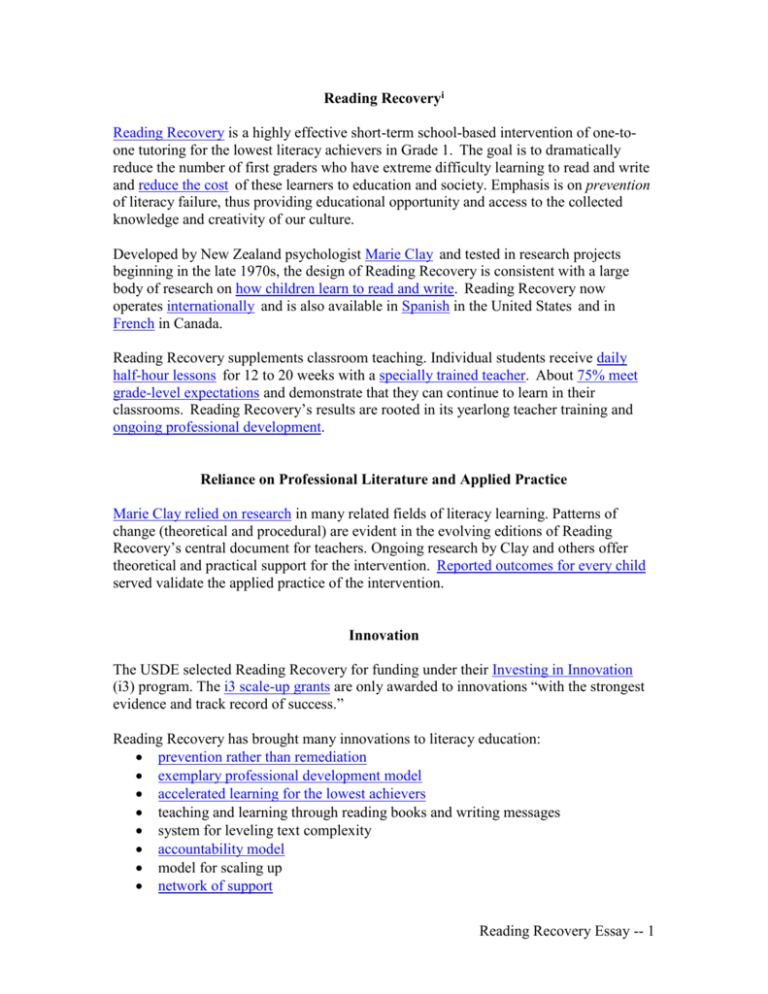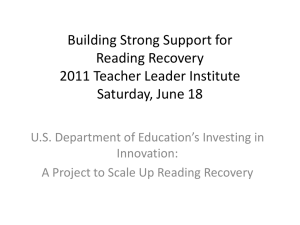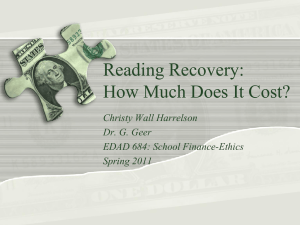Reading Recovery Essay
advertisement

Reading Recoveryi Reading Recovery is a highly effective short-term school-based intervention of one-toone tutoring for the lowest literacy achievers in Grade 1. The goal is to dramatically reduce the number of first graders who have extreme difficulty learning to read and write and reduce the cost of these learners to education and society. Emphasis is on prevention of literacy failure, thus providing educational opportunity and access to the collected knowledge and creativity of our culture. Developed by New Zealand psychologist Marie Clay and tested in research projects beginning in the late 1970s, the design of Reading Recovery is consistent with a large body of research on how children learn to read and write. Reading Recovery now operates internationally and is also available in Spanish in the United States and in French in Canada. Reading Recovery supplements classroom teaching. Individual students receive daily half-hour lessons for 12 to 20 weeks with a specially trained teacher. About 75% meet grade-level expectations and demonstrate that they can continue to learn in their classrooms. Reading Recovery’s results are rooted in its yearlong teacher training and ongoing professional development. Reliance on Professional Literature and Applied Practice Marie Clay relied on research in many related fields of literacy learning. Patterns of change (theoretical and procedural) are evident in the evolving editions of Reading Recovery’s central document for teachers. Ongoing research by Clay and others offer theoretical and practical support for the intervention. Reported outcomes for every child served validate the applied practice of the intervention. Innovation The USDE selected Reading Recovery for funding under their Investing in Innovation (i3) program. The i3 scale-up grants are only awarded to innovations “with the strongest evidence and track record of success.” Reading Recovery has brought many innovations to literacy education: prevention rather than remediation exemplary professional development model accelerated learning for the lowest achievers teaching and learning through reading books and writing messages system for leveling text complexity accountability model model for scaling up network of support Reading Recovery Essay -- 1 Replicability Transported from New Zealand, Reading Recovery has been replicated in thousands of education systems across Australia, the United States, Canada, and the United Kingdom. Summary data are reported annually in the United States by the International Data Evaluation Center (IDEC). Reading Recovery has a process for fidelity of implementation that ensures replicability and scalability: published set of standards and guidelines royalty-free trademark license intensive year-long university-based training, ongoing professional development, and university oversight annual evaluation of outcomes for every child Sustainability Reading Recovery has grown internationally since its beginning in New Zealand. Introduced in the United States in 1984 at The Ohio State University, Reading Recovery has served more than two million first graders. Although sometimes limited due to budget constraints, Reading Recovery continues to serve children (53,170 in 2011-2012). Measurement Methods An Observation Survey of Early Literacy Achievement (Clay, 2005) is used as a pre- and post-test assessment for Reading Recovery students and for a comparison group (random sample of class peers). The six tasks, developed in research studies with established reliability and validity, identify children at risk for literacy failure. Additional outcome data for every child and implementation process data are submitted on the secure IDEC website. Measureable Impact Reading Recovery has been examined by experimental and quasi-experimental studies, evaluation studies, research reviews, and meta-analyses. The USDE’s What Works Clearinghouse (WWC) established that Reading Recovery is an effective intervention based on scientific research. A federal i3 scale-up grant was awarded to Reading Recovery because this evidence showed a substantial effect on improving student achievement. WWC findings are supported by almost 30 years of evaluation data. Approximately 75% of the lowest-performing students with a full intervention reach grade-level expectations. For students still having some difficulty (about 25%), recommendations for future support are also a positive outcome for children. Reading Recovery Essay -- 2 Reading Recovery’s compelling research base also demonstrates effectiveness in reducing achievement gaps for low SES students, racial minorities, and English language learners; improving self-esteem; and promoting phonological awareness. Reading Recovery's wider impact includes: early identification of difficulties and early intervention assessment appropriate for beginning literacy learners theoretical influences on teaching and learning differentiated instruction through one-to-one teaching organized system for change Reading Recovery professionals and partners strive to open doors to a literate future for children who initially struggle in learning to read and write. Only then can these children access the collective knowledge and creativity of our culture. i URLs embedded in document links Reading Recovery http://readingrecovery.org/reading-recovery/teaching-children/basic-facts Reduce the cost http://readingrecovery.org/images/pdfs/Reading_Recovery/Research_and_Evaluation/long_term_costs_of_literacy_difficulties_2nd_e dition_2009.pdf Marie Clay http://readingrecovery.org/reading-recovery/teaching-children/marie-clay How children learn to read and write http://readingrecovery.org/reading-recovery/teaching-children/early-literacy-learning Internationally http://readingrecovery.org/reading-recovery/training/international-connections Spanish http://readingrecovery.org/reading-recovery/teaching-children/descubriendo-la-lectura French http://readingrecovery.org/reading-recovery/training/canadian-network Daily half-hour lessons http://readingrecovery.org/reading-recovery/teaching-children/lessons Specially trained teacher http://readingrecovery.org/reading-recovery/training/for-teachers 75% meet grade-level expectations http://readingrecovery.org/reading-recovery/training/for-teachers Ongoing professional development http://readingrecovery.org/reading-recovery/training/ongoing-training Marie clay relied on research http://readingrecovery.org/reading-recovery/teaching-children/marie-clay/jrr-tribute-to-marie-clay Reported outcomes for every child https://www.idecweb.us/ Investing in Innovation Reading Recovery Essay -- 3 http://www.i3.readingrecovery.info/ I3 scale up grants http://readingrecovery.org/reading-recovery/implementation/funding/i3-scale-up-grant-funding Prevention rather than remediation http://readingrecovery.org/images/pdfs/Membership/Futures_Chapter_11.pdf Exemplary professional development model http://readingrecovery.org/reading-recovery/training Accelerated learning for the lowest achievers https://readingrecovery.org/images/pdfs/Journals/JRR/Vol2_No1_Fall-2002/JRR_2.1-Jones.pdf Accountability model http://readingrecovery.org/reading-recovery/research Network of support http://readingrecovery.org/reading-recovery/training/training-centers Replicated in thousands of education systems http://readingrecovery.org/images/pdfs/Journals/JRR/Vol7_No1_Fall-2007/JRR_7.1-Clay.pdf Summary data are reported annually https://www.idecweb.us/Documentation.asp Published set of standards & guidelines http://readingrecovery.org/reading-recovery/implementation/standards-a-guidelines Royalty free trademark license http://readingrecovery.org/rrcna/about-rrcna/logo-requests Intensive year-long university-based training, ongoing professional development and university oversight http://readingrecovery.org/reading-recovery/training Annual evaluation of outcomes for every child https://www.idecweb.us/ Has grown internationally http://readingrecovery.org/reading-recovery/training/international-connections Continues to serve children https://www.idecweb.us/WebDocs/DocumentationTree/Evaluation%20Reports/20112012%20Reading%20Recovery%20National%20Statistical%20Abstract%20for%20the%20United%20States.pdf An Observation Survey of Early Literacy Achievement http://readingrecovery.org/reading-recovery/teaching-children/observation-survey Identify children at risk http://www.rti4success.org/screeningTools Additional outcome data for every child https://www.idecweb.us/Documentation.asp What Works Clearinghouse http://ies.ed.gov/ncee/wwc/interventionreport.aspx?sid=420 A federal i3 scale-up grant http://www2.ed.gov/programs/innovation/2010/awards/scale-up/oh.html 30 years of evaluation data http://readingrecovery.org/reading-recovery/research/data-evaluation-idec Positive outcome http://readingrecovery.org/reading-recovery/research/measuring-outcomes Reading Recovery’s compelling research base http://readingrecovery.org/reading-recovery/research Early identification of difficulties and early intervention http://readingrecovery.org/images/pdfs/Journals/JRR/Vol10_No1_Fall-2010/JRR_10.1_Vellutino.pdf Reading Recovery Essay -- 4 Assessment appropriate for beginning literacy learners http://readingrecovery.org/reading-recovery/teaching-children/observation-survey Theoretical influences on teaching and learning http://readingrecovery.org/reading-recovery/teaching-children/early-literacy-learning Differentiated instruction through one-to-one teaching http://readingrecovery.org/images/pdfs/Journals/JRR/Vol4_No1_Fall-2004/JRR_4.1-Askew_Simpson.pdf Organized system for change http://readingrecovery.org/images/pdfs/Journals/JRR/Vol7_No1_Fall-2007/JRR_7.1-Wilson-Barsky.pdf Reading Recovery Essay -- 5







